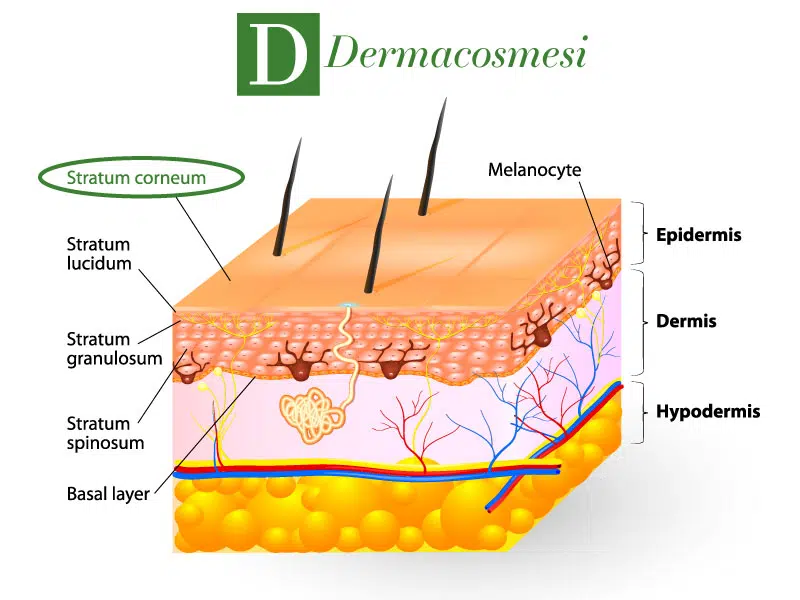The stratum corneum constitutes the outermost part of the skin; we can consider it a true protective envelope.
The stratum corneum consists of two very important compartments: let’s find out together what they are.
Contents
- 1 The compartments of the stratum corneum
- 2 The cellular compartment: the Corneocytes, the building blocks of the skin.
- 3 How the stratum corneum is created: everything is related to the stages of the keratocytes
- 4 The extracellular compartment: the cement of the skin, made of lipids and proteins
- 5 The stratum corneum performs very important functions for the skin
- 6 Barrier function against UV Rays of the stratum corneum
- 7 Protective function of the stratum corneum of the skin
- 8 Skin vitamins have antioxidant action
- 9 Skin waterproofing: the stratum corneum also performs this very important function
The compartments of the stratum corneum
The stratum corneum consists of two compartments:
- cellular compartment;
- extracellular compartment.
The cellular compartment: the Corneocytes, the building blocks of the skin.
The former composed of Corneocytes that form the building blocks, and the latter extracellular constitutes the cement.
The characteristics of the Corneocytes and the very important functions they perform in the stratum corneum
The cells present in the cellular part are called corneocytes, they have very special characteristics that are important for the functionality of the layer itself.
If we look at these cells we notice that they are flattened, lacking nucleus, dead.
The corneocytes form flake-like lamellae and with age, they increase in size
They are arranged to form flake-like lamellae.
Their surface area is quite large, and with increasing age, their size increases significantly as desquamation decreases and epidermal turnover slows, and corneocytes remain on the surface longer.
Corneocytes are cells without nuclei because there is no metabolic activity
They are cells without nuclei, and the fact that they lack internal organelles means that there is no metabolic activity.
Corneocytes are rich in proteins such as involucrin, loricrin and keratin
In the corneocytes, on the other hand, a number of proteins are present including involucrin, loricrin, but especially accumulations of keratin. This lamellar structure of corneocytes is crucial as it confers the real resistance to the epidermis when it undergoes mechanical stress.
The stratum corneum is created, thanks to a gradual superposition of keratocytes from the germinative layer, then spinous and finally granular.
In the latter layer, keratin accumulates more, the keratocytes die, the cells flatten out, forming first a very thin layer, called stratum lucidum (so called because it is refractive), and finally more on the surface the stratum corneum is created.
The extracellular compartment: the cement of the skin, made of lipids and proteins
In the intercellular spaces there are lipids, called hydroxyceramides, which form a real cement.
The lipids of the extracellular compartment, are organized to form lamellae parallel to the cells and composed mostly of: cholesterol, glucosyl-ceramides and fatty acids.
The proteins of the extracellular compartment
The extracellular part also contains nonenzymatic proteins, enzymes and antimicrobial molecules.
The stratum corneum performs very important functions for the skin
The stratum corneum, in order for it to perform its barrier action, must undoubtedly maintain a constant water content.
The extracellular lipid part turns out to be important in that it makes the skin impermeable.
The functions of the stratum corneum: from barrier function for ultraviolet rays to protective function
There are several functions of the stratum corneum, primarily that of a selective barrier. This function is due to the physical characteristics of its “wall structure with cement“, where the corneocytes are the bricks and the lipid substances the cement.
If we look at the other functions, we see that the stratum corneum is indispensable in that it acts as a true barrier against ultraviolet rays.
Barrier function against UV Rays of the stratum corneum
thanks to keratin and peptides, our skin has a barrier against UV rays, which are harmful to the body
In fact, it has been seen that keratin and peptides contained in this layer, protect the underlying structures of the epidermis from possible damage caused by UV rays.
Protective function of the stratum corneum of the skin
Against microorganisms and bacteria, our dermis is safe, thanks to its ph
The protective function of the stratum corneum is essential against microorganisms in addition.
The acid ph, the bacteriostatic action of lipids contained in the extracellular matrix, the low water content and proteolytic enzymes make the stratum corneum, the first defense mechanism.
Skin vitamins have antioxidant action
The presence also of the vitamins and enzymes with antioxidant action are important for the protection of the body itself.
Skin waterproofing: the stratum corneum also performs this very important function
Another and no less important function is waterproofing.
The stratum corneum in fact is deputed to control the dispersion of water through the skin, and from recent studies, it has been seen inoltra that it regulates all the layers below.
We can understand that it is of paramount importance to guard and preserve the integrity of this layer.
